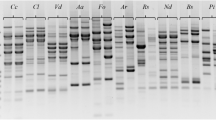Abstract
Thirty-two strains of the phytopathogenic mold Cylindrocladium scoparium (perfect state Calonectria morganii) isolated from ericaceous hosts and two specimens from the ATCC were examined by random amplification of polymorphic DNA (RAPD) and restriction fragment length polymorphism (RFLP). Five oligonucleotides were chosen as primers for differentiation of the isolates. RAPD patterns of the ATCC strains differed significantly from those of the field isolates. Diversity among field isolates was low. Results obtained in RFLP analysis, with telomere repeats of Neurospora crassa as a probe, were highly consistent with the RAPD data. Isolates were paired in all possible combinations; fertile perithecia occurred in only one combination, from which ascospores were analyzed by formal genetics and RAPD. A bipolar mechanism of homogenic incompatibility was found. Ascospore-derived strains were much more variable than field isolates. Phylogenetic trees suggested a correlation to the host plants from which the strains were isolated.
Similar content being viewed by others
Literature Cited
Arnau J, Housego AP, Oliver RP (1994) The use of RAPD markers in the genetic analysis of the plant pathogenic fungus Cladosporium fulvum. Curr Genet 25: 438–144
Cenis JL (1992) Rapid extraction of fungal DNA for PCR amplification. Nucleic Acids Res 20: 2380
Crous PW, Alfenas AC, Wingfield MJ (1993) Calonectria scoparia and Calonectria morgana sp. nov., and variation among isolates of their Cylindrocladium anamorphs. Mycol Res 97: 701–708
Crowhurst RN, Hawthorne BT, Rikkerink EHK, Tempelton MD (1991) Differentiation of Fusarium solani f. sp. cucurbitae races 1 and 2 by random amplification of polymorphic DNA. Curr Genet 20: 391–396
Fisher NL, Burgess LW, Toussoun TA, Nelson PE (1982) Carnation leaves as a substrate and for preserving cultures of Fusarium species. Phytopathology 72: 151–153
Gerlach W (1968) Calonectria uniseptata n. sp., die bisher unbekannte Hauptfruchtform von Cylindrocladium scoparium Morgan. Phytopathol. Z 61: 372–381
Grajal-Martin MJ, Simon CJ, Muehlbauer FJ (1993) Use of random amplified polymorphic DNA (RAPD) to characterize two races of Fusarium oxysporum f. sp. pisi. Phytopathology 83: 612–614
Guthrie PAI, Magill CW, Frederikson RA, Odvody GN (1992) Random amplified DNA markers: a system for identifying and differentiating isolates of Colletotrichum graminicola. Phytopathology 82: 832–835
Hulbert SH, Michelmore RW (1988) DNA restriction fragment length polymorphism and somatic variation in the lettuce downy mildew fungus, Bremia lactucae. Mol Plant-Microbe Interact 1: 17–24
Jacobson DJ, Gordon TR (1990) The variability of mitochondrial DNA as an indicator of the relationships between populations of Fusarium oxysporum f. sp. melonis. Mycol Res 94: 734–744
Koch E, Song K, Osborn TC, Williams PH (1991) Relationship between pathogenicity and phylogeny based on restriction fragment length polymorphism in Leptosphaeria maculans. Mol PlantMicrobe Interact 4: 341–349
Levy M, Romao J, Marchetti MA, Hamer JE (1991) DNA fingerprinting with a dispersed repeated sequence resolves pathotype diversity in the rice blast fungus. Plant Cell 3: 95–102
Morgan AP (1892) Two new genera of Hyphomycetes. Bot Gaz 17: 190–192
Neubauer C, Zinkernagel V (1995) Calonectria morganii (Crous, Alfenas & Wingfield), die Hauptfruchtform von Cylindrocladium scoparium Morgan. Z PflKrankh 102(3): 323–325
Peerally A (1991) The classification and phytopathology of Cylindrocladium species. Mycotaxon 40: 323–366
Quellet T, Seifert KA (1993) Genetic characterization of Fusarium graminearum strains using RAPD and PCR amplification. Genetics 83: 1003–1007
Ribeiro JO (1978) Heterotalismo em Cylindrocladium scoparium Morgan. M. Sc. Thesis, Universidade federal de Vicoso
Sambrook J, Fritsch EF, Maniatis T (1989) Molecular cloning, a laboratory manual, 2nd ed. Cold Spring Harbor, NY: Cold Spring Harbor Laboratory Press
Schechtmann MG (1990) Characterization of telomere DNA from Neurospora crassa. Gene 88: 159–165
Smith ML, Anderson JB (1989) Restriction fragment length polymorphisms in mitochondrial DNAs of Armillaria: identification of North American biological species. Mycol Res 93: 247–256
Southern E (1975) Detection of specific sequences among DNAfragments separated by gel electrophoresis. J Mol Biol 98: 503–517
Swofford DL, Beagle DP (1993) PAUP phylogenetic analysis using parsimony. Version 3.1 User’s manual. Illinois National History Survey, Champaign, Illinois, USA
Tzeng TH, Lyngholm LK, Ford CF, Branson CR (1992) A restriction fragment length polymorphism map and electrophoretic karyotype of the fungal maize pathogen Cochliobolus heterostrophus. Genetics 130: 81–96
Valent B, Chumley FG (1991) Molecular genetic analysis of the rice blast fungus Magnaporte grisea. Annu Rev Phytopathol 27: 142–164
Van der Vlugt-Bergmanns CJB, Brandwagt BF, Van’t Klooster JW, Wagemakers CAM, Van Kan JAL (1993) Genetic variation and segregation of DNA polymorphisms in Botrytis cinerea. Mycol Res 97: 1193–1200
Vilgalys R, Gonzales D (1990) Ribosomal DNA restriction fragment length polymorphisms in Rhizoctonia solani. Phytopathology 80: 151–158
Voigt K, Schleier S, Brückner B (1995) Genetic variability in Gibberella fujikoroi and some related species of the genus Fusarium based on random amplification of polymorphic DNA (RAPD). Curr Genet 27: 528–535
Weising K, Kaemmer D, Epplen JT, Weigand F, Saxena M, Kahl G (1991) DNA fingerprinting of Ascochyta rabiei with synthetic oligonucleotides. Curr Genet 19: 483–489
Welsh J, McClelland M (1990) Fingerprinting genomes using PCR with arbitrary primers. Nucleic Acid Res 18: 7213–7218
Williams JGK, Kubelik AR, Livak KJ, Rafalski JA, Tingey SV (1990) DNA polymorphisms amplified by arbitrary primers are useful as genetic markers. Nucleic Acids Res 18: 6531–6535
Author information
Authors and Affiliations
Rights and permissions
About this article
Cite this article
Overmeyer, C., Lünnemann, S., von Wallbrunn, C. et al. Genetic variability among isolates and sexual offspring of the plant pathogenic fungus Calonectria morganii on the basis of random amplification of polymorphic DNA (RAPD) and restriction fragment length polymorphism (RFLP). Current Microbiology 33, 249–255 (1996). https://doi.org/10.1007/s002849900108
Received:
Accepted:
Issue Date:
DOI: https://doi.org/10.1007/s002849900108




